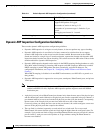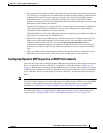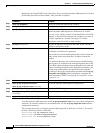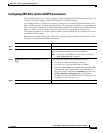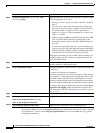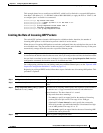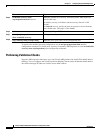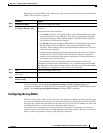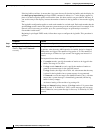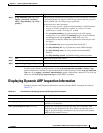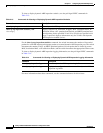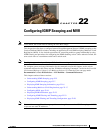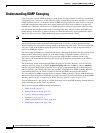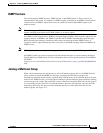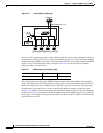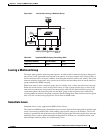
21-14
Catalyst 2960 and 2960-S Switch Software Configuration Guide
OL-8603-09
Chapter 21 Configuring Dynamic ARP Inspection
Configuring Dynamic ARP Inspection
If the log buffer overflows, it means that a log event does not fit into the log buffer, and the display for
the show ip arp inspection log privileged EXEC command is affected. A -- in the display appears in
place of all data except the packet count and the time. No other statistics are provided for the entry. If
you see this entry in the display, increase the number of entries in the log buffer or increase the logging
rate.
The log buffer configuration applies to each stack member in a switch stack. Each stack member has the
specified logs number entries and generates system messages at the configured rate. For example, if the
interval (rate) is one entry per second, up to five system messages are generated per second in a
five-member switch stack.
Beginning in privileged EXEC mode, follow these steps to configure the log buffer. This procedure is
optional.
Command Purpose
Step 1
configure terminal Enter global configuration mode.
Step 2
ip arp inspection log-buffer {entries
number | logs number interval
seconds}
Configure the dynamic ARP inspection logging buffer.
By default, when dynamic ARP inspection is enabled, denied or dropped
ARP packets are logged. The number of log entries is 32. The number of
system messages is limited to 5 per second. The logging-rate interval is 1
second.
The keywords have these meanings:
• For entries number, specify the number of entries to be logged in the
buffer. The range is 0 to 1024.
• For logs number interval seconds, specify the number of entries to
generate system messages in the specified interval.
For logs number, the range is 0 to 1024. A 0 value means that the entry
is placed in the log buffer, but a system message is not generated.
For interval seconds, the range is 0 to 86400 seconds (1 day). A 0 value
means that a system message is immediately generated (and the log
buffer is always empty).
An interval setting of 0 overrides a log setting of 0.
The logs and interval settings interact. If the logs number X is greater than
interval seconds Y, X divided by Y (X/Y) system messages are sent every
second. Otherwise, one system message is sent every Y divided by X (Y/X)
seconds.



